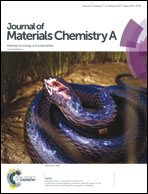A phytic acid etched Ni/Fe nanostructure based flexible network as a high-performance wearable hybrid energy storage device†
Abstract
We develop a 3D nanowire-supported Cu network through electrodepositing an active metal layer (NiZn alloy and Fe) to grow NiZn–phytate and Fe–phytate nanostructures as the anode and cathode, respectively, of a flexible energy storage device. Besides, this work aims to discuss the reasons behind the energy storage mechanism via the Dunn’s method and the results reveal that our device exhibits both surface capacitive effects and diffusion-controlled insertion processes, suggesting that it combines the properties of batteries and capacitors during the charge storage process. Therefore, the fabricated Ni/Fe cell can deliver high energy (185.33 W h kg−1) and power densities (15.93 kW kg−1), surpassing many recently reported appliances, such as commercial Li thin-film batteries, supercapacitors and other Ni/Fe batteries. Additionally, the Ni/Fe full cell also shows desirable long-term stability (about 86% retention after 8000 cycles at 20.83 A g−1). Moreover, the Ni/Fe cell can maintain its electrochemical performance under various bending states as well as being a promising power supply for wearable smart products. These features demonstrate that our proposed cell has potential for practical application as a next generation energy storage device. Importantly, the green and facile approach involving the application of phytic acid, which is abundant in living organisms, can be used to fabricate electrodes in our future research.



 Please wait while we load your content...
Please wait while we load your content...